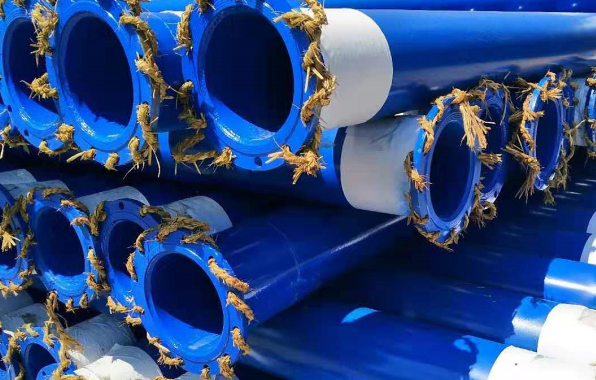
Plastic Coating for ASTM A106 Gr.B Seamless Steel Pipe
So, why is plastic coating necessary for ASTM A106 Gr.B seamless steel pipe?
This mainly stems from some challenges in practical applications. For example, when transporting certain chemical fluids, the chemical components in the fluid may corrode the inner wall of the steel pipe, potentially leading to thinning or even perforation over time. Similarly, if the pipeline is installed outdoors or underground, moisture in the external environment and salt in the soil may also corrode the outer wall of the steel pipe. The plastic coating acts like a "protective suit" for the steel pipe, effectively isolating it from direct contact with corrosive media and significantly extending its service life.

Next, let's take a closer look at the specific process of plastic coating. Plastic coating is not simply applying plastic to the steel pipe; it's a rigorous process.
1. Surface Pretreatment. This is a crucial step in the plastic coating process. Before coating, the steel pipe surface must be thoroughly cleaned, free of oil, rust, scale, and any other impurities. Typically, sandblasting or shot blasting is used for rust removal, achieving a certain level of cleanliness and roughness. Proper surface pretreatment ensures a tight bond between the plastic coating and the steel pipe substrate, preventing coating peeling later.
2. Preheating. After surface cleaning, the steel pipe undergoes preheating. Preheating removes any moisture from the surface and brings the pipe to a suitable coating temperature. An appropriate preheating temperature helps the plastic powder melt and flow rapidly upon contact with the steel pipe surface, forming a uniform and continuous coating.
3. Coating. This is the core coating step. Depending on the process, it can be divided into electrostatic spraying, dip coating, and other methods. Taking the common electrostatic spraying as an example, electrostatically charged plastic powder is evenly sprayed onto the preheated steel pipe surface. Due to electrostatic adsorption, the powder adheres tightly to the steel pipe. There are many types of plastic powders, such as epoxy resin and polyethylene, each with different properties and suitable for different working conditions.
4. Curing and Leveling. The steel pipe coated with plastic powder enters a curing oven. At a set temperature, the powder melts, cross-links, and cures, ultimately forming a dense, smooth protective layer. Temperature and time control in this process are crucial, directly affecting the final performance of the coating, such as adhesion, impact resistance, and corrosion resistance.
5. Cooling and Inspection. After curing, the steel pipe needs to be cooled. Afterward, a rigorous quality inspection is conducted to check whether the coating thickness is uniform, the surface is smooth and defect-free, and the adhesion meets standards. Only plastic-coated steel pipes that pass the inspection can be shipped and put into use.
When choosing coating materials, people may ask: What are the commonly used coating materials? What are their characteristics? Currently, the most widely used are mainly epoxy resin and polyethylene.
1. Epoxy Resin Coating. Epoxy resin coatings have excellent adhesion to the metal substrate, and the coating is hard, wear-resistant, and has excellent corrosion resistance. It is particularly suitable for the internal corrosion protection of pipelines transporting oil, chemical media, and sewage. Its operating temperature range is also wide, adapting to various working conditions.
2. Polyethylene Coating. Polyethylene coatings are known for their excellent impact resistance, flexibility, and insulation properties. It has good resistance to moisture and chemical corrosion and is often used for the corrosion protection of the outer walls of pipelines, especially in underground laying and road crossings where external impact or friction may occur. The surface of the polyethylene coating is smoother, reducing fluid transport resistance.
What performance improvements are achieved in ASTM A106 Gr.B seamless steel pipes after plastic coating?
We can look at it from the following perspectives:
1. Enhanced Corrosion Resistance. This is the most significant improvement. The plastic coating effectively isolates the steel pipe from corrosive environments. Neither the medium contacting the inner wall nor the environment surrounding the outer wall can directly corrode the steel pipe, thus significantly slowing down the corrosion rate.
2. Extended Service Life: The improved corrosion resistance reduces the risk of pipeline damage due to corrosion, naturally extending its safe service life. This means that the frequency of pipe replacement and related maintenance costs are expected to decrease throughout the project's lifecycle.
3. Reduced Friction Coefficient: The inner wall of the plastic coating is typically very smooth, reducing resistance to fluid flow within the pipe. For long-distance pipelines, this helps reduce pumping energy consumption, resulting in significant energy savings over the long term, which translates to substantial RMB savings.
4. Physical Protection: The coating, especially a tough coating like polyethylene, can buffer against external physical impacts to the steel pipe, reducing mechanical damage.
Precautions for the Transportation, Storage, and Installation of Plastic-Coated Steel Pipes:
During transportation and handling, avoid violent impacts and throwing to prevent damage to the coating. Store on a flat surface, avoiding prolonged exposure to direct sunlight and rain. During installation, if welding is required, pay special attention to protecting the coating around the weld area, and repair any damaged areas according to specifications after welding.
Coating ASTM A106 Gr.B seamless steel pipes with plastic is an effective technique to improve overall pipeline performance and extend their service life. It adds a robust plastic protective layer to the steel pipe, making it more adaptable to complex and harsh working environments. Understanding the process, material properties, and precautions during selection and use helps to better utilize its effectiveness and ensure the safe, stable, and long-term operation of various pipeline projects.
Read more: Seamless Steel Pipe Sizes
- 【Prev】 : Seamless Pipe Wholesale Market Trends and Purchasing Guide
- 【Next】 : No infomation!


